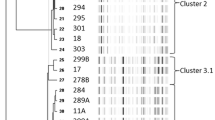Abstract
Chromogenic chromID® CARBA medium was compared with CDC method and MacConkey agar with imipenem for its performance in detecting carbapenemase-producing Enterobacteriaceae (CPE) during a faecal screening surveillance program. Double rectal swabs were collected from patients hospitalized in the ICU. One swab was inoculated onto the solid media chromID® CARBA and MacConkey agar with imipenem, while the other was tested according to CDC protocol. Suspected colonies from all procedures were identified to species level and tested for their susceptibility to carbapenems by phenotypic tests. All carbapenem non-susceptible isolates were tested by the modified Hodge test (MHT) and synergy tests. Positive results were confirmed by PCR testing for carbapenemase gene detection. Performance of all three procedures applied was statistically analyzed as compared to MHT and PCR results for the presence of carbapenemase-encoding genes. Out of 177 rectal samples tested, 86 samples were found to contain one or more CPE verified by molecular detection of carbapenemase encoding genes among isolated Enterobacteriaceae. Sensitivity of chromID® CARBA was 96.5 % in clinical samples. Specificity was 91.2 % at the reading level and 100.0 % after Gram staining. chromID® CARBA performed with high accuracy among the phenotypic methods applied, giving early results.

Similar content being viewed by others
References
Grundmann H, Livermore DM, Giske CG, Canton R, Rossolini GM, Campos J et al (2010) Carbapenem-non-susceptible Enterobacteriaceae in Europe: conclusions from a meeting of national experts. Euro Surveill 15(46)
Nordmann P, Cuzon G, Naas T (2009) The real threat of Klebsiella pneumoniae carbapenemase-producing bacteria. Lancet Infect Dis 9:228–236
Cohen Stuart J, Leverstein-Van Hall MA, Dutch Working Party on the Detection of Highly Resistant Microorganisms (2010) Guideline for phenotypic screening and confirmation of carbapenemases in Enterobacteriaceae. Int J Antimicrob Agents 36:205–210
Souli M, Galani I, Antoniadou A, Papadomichelakis E, Poulakou G, Panagea T et al (2010) An outbreak of infection due to beta-lactamase Klebsiella pneumoniae carbapenemase 2-producing K. pneumoniae in a Greek University Hospital: molecular characterization, epidemiology, and outcomes. Clin Infect Dis 50:364–373
Schechner V, Straus-Robinson K, Schwartz D, Pfeffer I, Tarabeia J, Moskovich R et al (2009) Evaluation of PCR-based testing for surveillance of KPC-producing carbapenem-resistant members of the Enterobacteriaceae family. J Clin Microbiol 47:3261–3265
Birgy A, Bidet P, Genel N, Doit C, Decré D, Arlet G, Bingen E (2012) Phenotypic screening of carbapenemases and associated β-lactamases in carbapenem-resistant Enterobacteriaceae. J Clin Microbiol 50:1295–1302
Centers for Disease Control and Prevention (CDC) (2009) Laboratory protocol for detection of carbapenem-resistant or carbapenemase-producing, Klebsiella spp. and E. coli from rectal swabs. Centers for Disease Control and Prevention. http://www.cdc.gov/NCIDOD/DHQP/pdf/ar/Klebsiella_or_Ecoli. Accessed 16 July 2013
Clinical and Laboratory Standards Institute (CLSI) (2011) Performance standards for antimicrobial susceptibility testing: Twenty-second informational supplement (M100-S21). CLSI, Wayne, PA
Pournaras S, Poulou A, Tsakris A (2010) Inhibitor-based methods for the detection of KPC carbapenemase-producing Enterobacteriaceae in clinical practice by using boronic acid compounds. J Antimicrob Chemother 65:1319–1321
Seah C, Low DE, Patel SN, Melano RG (2011) Comparative evaluation of a chromogenic agar medium, the modified Hodge test, and a battery of meropenem-inhibitor discs for detection of carbapenemase activity in Enterobacteriaceae. J Clin Microbiol 49:1965–1969
Vrioni G, Daniil I, Voulgari E, Ranellou K, Koumaki V, Ghirardi S et al (2012) Comparative evaluation of a prototype chromogenic medium (chromID® CARBA) for detecting carbapenemase-producing Enterobacteriaceae in surveillance rectal swabs. J Clin Microbiol 50:1841–1846
Kotsakis SD, Petinaki E, Scopes E, Siatravani E, Miriagou V, Tzelepi E (2013) Laboratory evaluation of Brilliance™ CRE Agar for screening carbapenem-resistant Enterobacteriaceae: Performance on a collection of characterised clinical isolates from Greece. J Global Antimicrob Res 1:85–90
Vatopoulos A (2008) High rates of metallo-beta-lactamase-producing Klebsiella pneumoniae in Greece-a review of the current evidence. Euro Surveill 13(4)
Pournaras S, Protonotariou E, Voulgari E, Kristo I, Dimitroulia E, Vitti D et al (2009) Clonal spread of KPC-2 carbapenemase-producing Klebsiella pneumoniae strains in Greece. J Antimicrob Chemother 64:348–352
Papadimitriou-Olivgeris M, Marangos M, Fligou F, Christofidou M, Bartzavali C, Anastassiou ED et al (2012) Risk factors for KPC-producing Klebsiella pneumonia enteric colonization upon ICU admission. J Antimicrob Chemother 67:2976–2981
Wilkinson KM, Winstanley TG, Lanyon C, Cummings SP, Raza MW, Perry JD (2012) Comparison of four chromogenic culture media for carbapenemase-producing Enterobacteriaceae. J Clin Microbiol 50:3102–3104
Acknowledgments
Ethical approval
The study was carried out under the permission of the University Hospital Ethical Committee (No. 571).
Funding
This work was supported by bioMérieux SA (evaluation protocol reference Number 43861).
Authorship/contribution
M.P.O. collected the samples, performed the susceptibility tests and wrote the manuscript. C.B. identified bacteria to species level, kept frozen the isolates and reviewed the paper. M.C. collected data, supervised all phenotypes and genotypes and reviewed the manuscript. N.B. performed the PCRs and reviewed the manuscript. J.H. and G.Z. designed the study protocol, collected the data, performed part of the statistical analysis and reviewed the article. I.S. reviewed and took part in designing the study protocol, supervised all experiments, collection of data and wrote the article.
Conflict of interest
M.P.O and C.B. were financially supported by the funding of bioMérieux SA (evaluation protocol reference number 43861) to the University of Patras. N.B., J.H. and G.Z. work at bioMérieux SA, Marcy L’Etoile, France.
Author information
Authors and Affiliations
Corresponding author
Rights and permissions
About this article
Cite this article
Papadimitriou-Olivgeris, M., Bartzavali, C., Christofidou, M. et al. Performance of chromID® CARBA medium for carbapenemases-producing enterobacteriaceae detection during rectal screening. Eur J Clin Microbiol Infect Dis 33, 35–40 (2014). https://doi.org/10.1007/s10096-013-1925-6
Received:
Accepted:
Published:
Issue Date:
DOI: https://doi.org/10.1007/s10096-013-1925-6



